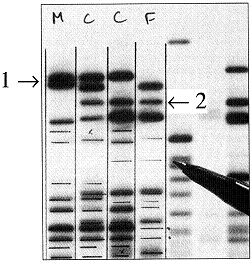In a two-point cross to map genes A and B, you obtained 98 recombinant types and 902 parental types among the offspring. How far apart are these genes?
A. .098 cM
B. 90.2 cM
C. 9.8 cM
D. 9.02 cM
E. 0.98 cM
Answer: C
You might also like to view...
In what types of rocks are fossils most likely to be found?
A. igneous, formed by lava flow B. conglomerate C. sedimentary D. metamorphic
The reproductive organ in the human female
that is responsible for egg production is the
a. uterus. b. ovary. c. vagina. d. clitoris. e. oviduct
The columns in the accompanying figure represent F (for female), C (for children), and M (for male). The presence of the band marked with arrow #2, shows that:

a. this DNA sequence in the children is a mutation.
b. this DNA sequence in the children is inherited from their mother.
c. this DNA sequence in the children is inherited from their father.
d. this sequence in the children is inherited from both their mother and father.
e. individual F is not the mother of these children.
What was the evolutionary advantage of the modification of scales on reptiles to feathers on ancestral birds?
a. The feathers helped retain body heat. b. Feathers provided a better means of expressing mating behavior. c. Feathers provided flight. d. Feathers made birds that evolved early less likely to become prey. e. Feathers provided camouflage for nesting birds.